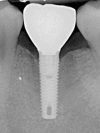One-Piece Monolithic Zirconia Single Tooth Implant-Supported Restorations in the Posterior Region: A 1-Year Prospective Case Series Study
- PMID: 39711513
- PMCID: PMC11996735
- DOI: 10.1111/clr.14396
One-Piece Monolithic Zirconia Single Tooth Implant-Supported Restorations in the Posterior Region: A 1-Year Prospective Case Series Study
Abstract
Objective: To assess the clinical, radiographic and patient-reported outcome measures, and the success of screw-retained one-piece monolithic zirconia implant-supported restorations in the posterior region during a 1-year follow-up.
Methods: In a prospective case series, 50 single molar sites in the posterior region of 41 patients with a minimum age of 18 years and sufficient bone volume for placing an implant (≥ 8 mm) and space for an anatomical restoration were included. Following prosthetic-driven digital three-dimensional treatment planning, a tissue-level implant with an internal connection was inserted during a one-stage surgical procedure. Three months later, the implant was restored with a screw-retained one-piece monolithic zirconia restoration. Clinical, radiographic and patient-reported outcome measures, and restoration survival and success according to the modified USPHS criteria were assessed at baseline prior to and immediately after implant placement, and 1-month and 1-year after definitive restoration placement.
Results: At the 1-year follow-up, 1 implant had been lost (implant survival rate 98%) hence, 49 restorations were evaluated. The restoration survival and success rates were 100% and 98%, respectively. Plaque, calculus, bleeding and suppuration on probing and peri-implant inflammation were absent in most cases. The mean (SD) marginal bone level change between implant placement and the 1-year follow-up was -0.14 mm (0.27) on the mesial and -0.25 mm (0.31) on the distal side. The mean (SD) patient satisfaction (0-10) was 9.2 (0.8) at the 1-year evaluation.
Conclusion: One-piece monolithic zirconia implant-supported restorations exhibited favourable outcomes over 1 year in situ.
Trial registration: Registered in the National Trial Register (NL9059).
Keywords: digital workflow; implant‐supported; monolithic; restoration; zirconia.
© 2024 The Author(s). Clinical Oral Implants Research published by John Wiley & Sons Ltd.
Conflict of interest statement
The authors declare no conflicts of interest.
Figures






Similar articles
-
Monolithic zirconia single tooth implant-supported restorations with CAD/CAM titanium abutments in the posterior region: A 1-year prospective case series study.Clin Implant Dent Relat Res. 2022 Feb;24(1):125-132. doi: 10.1111/cid.13069. Epub 2022 Jan 24. Clin Implant Dent Relat Res. 2022. PMID: 35075756 Free PMC article.
-
Full-zirconia single-tooth molar implant-supported restorations with angulated screw channel abutments: A 1-year prospective case series study.Clin Implant Dent Relat Res. 2020 Feb;22(1):138-144. doi: 10.1111/cid.12872. Epub 2019 Dec 3. Clin Implant Dent Relat Res. 2020. PMID: 31793193 Free PMC article.
-
Full-Zirconia Single Molar Implant-Supported Restorations With Angulated Screw Channel Abutments: 5-Year Results of a Prospective Case Series Study.Clin Implant Dent Relat Res. 2025 Jun;27(3):e70068. doi: 10.1111/cid.70068. Clin Implant Dent Relat Res. 2025. PMID: 40525617 Free PMC article.
-
Monolithic zirconia as a valid alternative to metal-ceramic for implant-supported single crowns in the posterior region: A systematic review and meta-analysis of randomized controlled trials.J Prosthet Dent. 2024 Nov;132(5):881-889. doi: 10.1016/j.prosdent.2023.05.006. Epub 2023 Jun 21. J Prosthet Dent. 2024. PMID: 37349158
-
Group 2 ITI Consensus Report: Prosthodontics and implant dentistry.Clin Oral Implants Res. 2018 Oct;29 Suppl 16:215-223. doi: 10.1111/clr.13298. Clin Oral Implants Res. 2018. PMID: 30328196
References
-
- Alqutaibi, A. Y. , Alnazzawi A. A., Algabri R., Aboalrejal A. N., and AbdElaziz M. H.. 2021. “Clinical Performance of Single Implant‐Supported Ceramic and Metal‐Ceramic Crowns: A Systematic Review and Meta‐Analysis of Randomized Clinical Trials.” Journal of Prosthetic Dentistry 126, no. 3: 369–376. 10.1016/j.prosdent.2020.06.011. - DOI - PubMed
-
- Berglundh, T. , Armitage G., Araujo M. G., et al. 2018. “Peri‐Implant Diseases and Conditions: Consensus Report of Workgroup 4 of the 2017 World Workshop on the Classification of Periodontal and Peri‐Implant Diseases and Conditions.” Journal of Clinical Periodontology 45: S286–S291. 10.1111/jcpe.12957. - DOI - PubMed
-
- Bienz, S. P. , Hilbe M., Hüsler J., Thoma D. S., Hämmerle C. H. F., and Jung R. E.. 2021. “Clinical and Histological Comparison of the Soft Tissue Morphology Between Zirconia and Titanium Dental Implants Under Healthy and Experimental Mucositis Conditions—A Randomized Controlled Clinical Trial.” Journal of Clinical Periodontology 48, no. 5: 721–733. 10.1111/jcpe.13411. - DOI - PubMed
MeSH terms
Substances
Grants and funding
LinkOut - more resources
Full Text Sources

